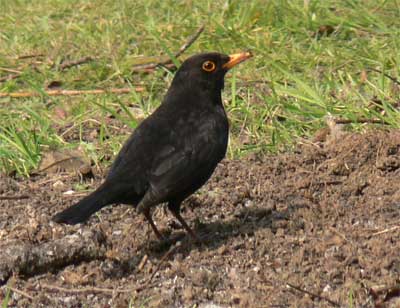Blackbird deathwish?
- Complaining about the Mainland - 17th August, 2024
- New island designation – is it just greenwash? - 26th April, 2024
- Police and Crime Commissioners – a solution or a problem? - 21st April, 2024
Known as blackie, merle, ouzel and zulu in various parts of Britain, the blackbird is not only one of the most widespread of our breeding birds, but it also one of the most numerous, numbering some seven million pairs: although numbers have fallen by over a third since the 1970s.

Perhaps a small part of the reason for this decline could be roadkills. In a recent post the Wildlife Gardener asks:
Why do blackbirds do that death wish dipping swoop across roads?
It’s an interesting question. The Ranger doesn’t know much of these things, but if you don’t mind that, some speculation might be in order. It is linked to another similar phenomenon – the pheasant in the road. Why do some birds have a characteristic response when faced with a vehicle? In the case of blackbirds, they typically swoop low across the path of the oncoming car, perhaps emerging from a hedgerow and just making it to the other side before the car sweeps by. In the case of a pheasant they commonly emerge onto the road in front of a vehicle, and then run along frantically until they can get off the road – and along the sunken lanes of southern England this can sometimes be a frustratingly long way for all concerned. Why does the pheasant not simply fly away? Why does the blackbird not simply fly higher? Both can do so, but choose not to. The answer is the same in both cases: predator avoidance. The pheasant has a characteristic behaviour that has made it a perennially popular shooting bird – it tends to run along the ground as far as it can when faced with an enemy, before finally rising into the sky with a clumsy flight. It’s not a great flyer, being heavy and slow, whereas it can run pretty fast for a bird. So it makes sense for the pheasant to run as far as it possibly can, because usually this will be enough to get it out of trouble. It will only fly as a last resort, as this takes a lot of energy. The blackbird, by contrast, will fly readily – perhaps too readily in the case of the roadside. Usually the bird would be safer to remain in the hedge. But to a blackbird, a vehicle approaching fast can’t really be anything but a threat. And when a blackbird is threatened, its response is to fly a short distance away at low altitude. Unlike the pheasant the blackbird can’t make much progress hopping along the ground, so flight is the safest option. Blackbirds are fiercely territorial, so they don’t want to fly far away as they will want to remain in or near their territory. A typical predator attack would come from a raptor or corvid attacking from above. The quickest way to get away from the immediate threat is to make a short flight, and so they don’t want to waste time rising high into the air. Unfortunately this low, swooping escape flight does precisely nothing to avoid a car driving towards them – hence the occasional sad blackbird corpse that can be seen on the roadside. The consolation is that, for blackbirds, encounters with crows or sparrowhawks are probably more common than cars, and assuming this is the case, on average the blackbirds will have still got it right.

Good comments above and both equally valid. The Blackbird is seldom a high flyer, it nests lower than most, feeds on the ground mostly, though itproclaims territory often from lofty perch, roos of houses for instance. Perhaps (together with the comments above) it doesn’t have high flying in its vocabulary for evasion.
I know evolution takes a long time, but if road kills are putting selection pressures on the blackbirds you should eventually breed one that avoids cars. Maybe they are out there already but we don’t see them by the roads because they, you know, avoid cars.
Seriously though, if avoiding car behavior puts them at a disadvantage vs. the real predators (other birds) who knows how evolution might go.
I have this same thought whenever I see any roadkill. Birds, squirrels, deer, you name it.
The average avian predator of most bird species (I exclude the Peregrine versus Rock Dove) travels at UP TO c.40 mph. Birds are adapted to judge any moving object up to around that speed. Unfortunately, many vehicles are driven along country roads at speeds well in excess of this … and, therefore, the casualties mount as collisions become inevitable for some!
The answer is … to slow down.